Original bedspreads from denim patches
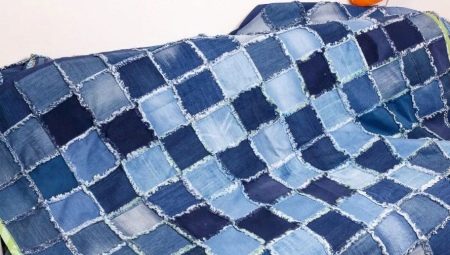
An original bedspread made of denim scraps is the thing that will help create spectacular accents in the interior and make the style of your home unique, modern, in the spirit of the latest trends. We offer ideas, descriptions, analysis of popular techniques.
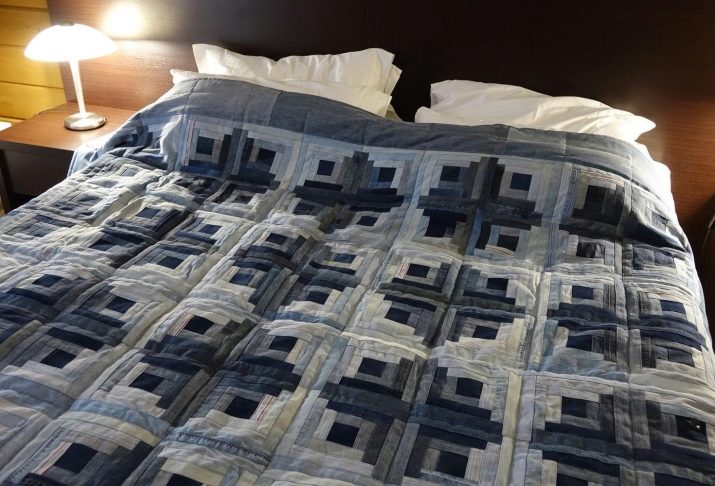
Features and rules of sewing
The history of patchwork is more than one hundred years old. Our great-grandmothers perfectly mastered the art of harmoniously combining different pieces of fabric. This is quite a creative and exciting activity.
Patchwork is done in a patchwork style and is a great way to use leftover trimmings, scraps, and pieces of fabric. This sewing technique is simple and allows even a novice needlewoman to create original attractive things.
Most often these are throws, blankets, bedspreads, pillow cases, wall and floor rugs. Products made in this style are always at the height of fashion.
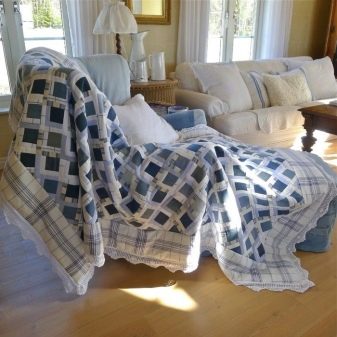
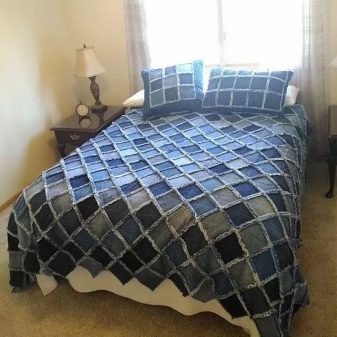
A patchwork quilt or bedspread is an indispensable item in household use, belongs to the category of home textiles, creates a unique warm atmosphere and comfort, is an exclusive expression of the needlewoman's creativity, has its own unique style, harmoniously complements the interior of the room, adding a certain zest to it.
A plaid or a blanket made of denim rags looks very actual and fashionable. Thanks to durable denim, such a thing will last for many years and will never go out of fashion. Previously, the patchwork technique was used because of the lack of fabric, out of poverty, as they say. Now it is a fashion trend.And craftswomen use not only unnecessary scraps, scraps, old things when creating their works. Today, you can find whole patchwork kits on sale with cuts of brand new fabrics. They are created by professional designers, updating the collections annually.
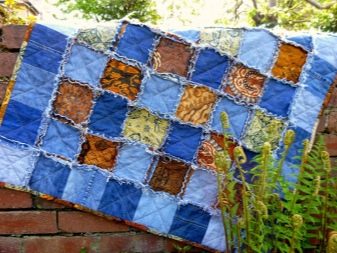

Overview of flap stitching techniques
There are several techniques for sewing flaps - simple and complex. For beginners, it is better to use the simplest method - squares, which are cut according to the finished template. This technique of sewing flaps is simple and even the most inexperienced novice needlewomen can do it. The product can be made not only from squares, but also from circles, rectangles, triangles and other geometric shapes. Just squares are the easiest patchwork sewing option. Let's take a look at the most popular techniques for joining fabric pieces.
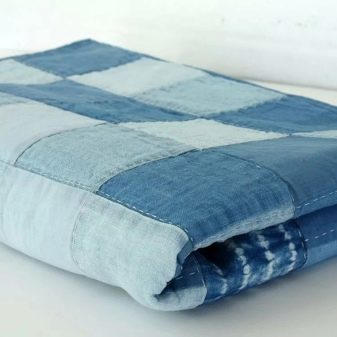
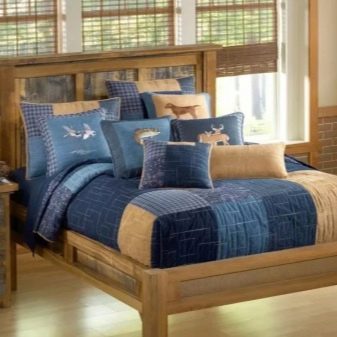
"Well"
This option for stitching pieces of matter is quite simple: The patches connected in a special way create the illusion of the depth of the well. A fairly creative and original technique, dating back several centuries, was most popular in Europe and America. The technique is based on a square, which consists of separate strips of different fabrics. There are several options for connecting strips (they are also called "logs").
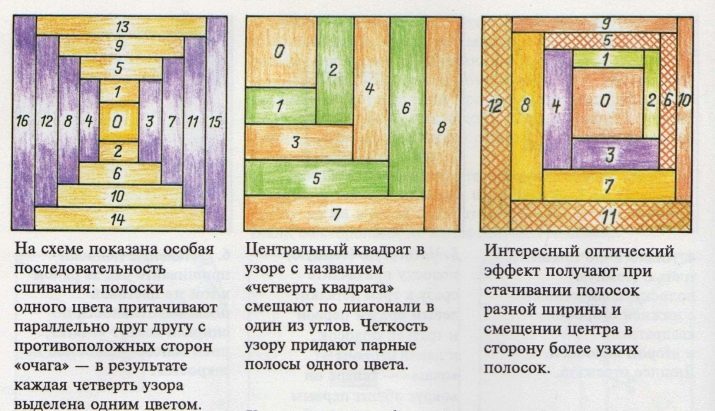
The most popular and easiest way:
- multi-colored stripes in a spiral, light and dark, are sharpened to the central square (it is the center of the composition and a color accent);
- the first two strips are sewn to opposite sides of the square, each next strip is sewn in such a way as to capture the previous element.
The movement is clockwise. When the main tier of the well is ready, the technique is repeated, the tiers are built up in a similar sequence. It turns out something like a fashionable 3D drawing, three-dimensional and deep.
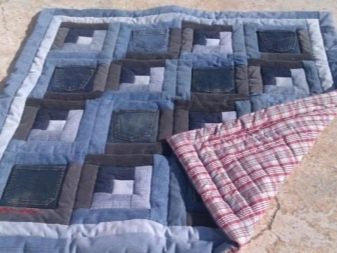
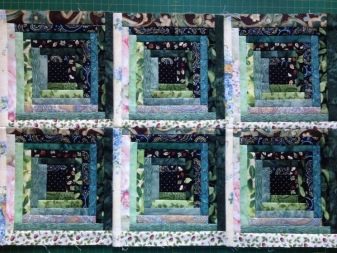
"Watercolor"
The watercolor technique allows you to create a product with different shades and tints. Individual parts must be connected in series to create a color composition. Each element is one tone lighter or darker than the main color, first darker tones are stitched together, then lighter ones are added.
It is quite difficult to make a blanket out of jeans using this technique, but it is possible. The color palette of denim is limited to a few shades, so the selection of patches and alignment of the color sequence will take longer.
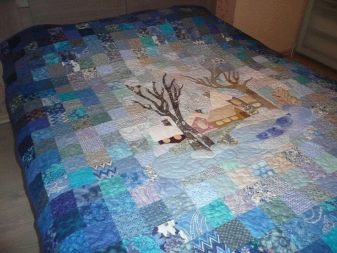
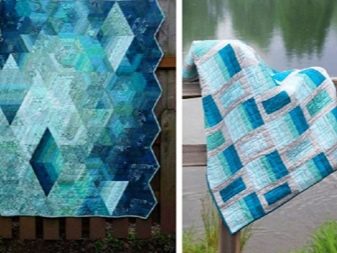
"Fast squares"
The easiest and most affordable patchwork option for beginner needlewomen. This technique allows you to sew a bedspread in a few hours.... To do this, you need to cut 3-4 rectangular strips of fabric of different colors, stitch them along the long side. As a result, a whole piece of canvas is obtained, from which squares-blocks of the required size are cut, then the blocks are connected to each other.

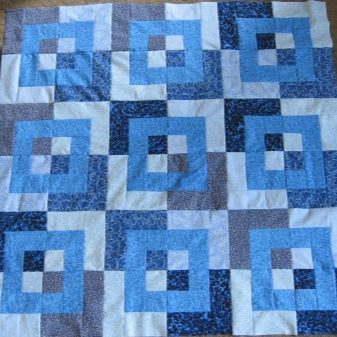
Crazy patchwork
This technique is for advanced and experienced needlewomen. Products made using this technique are real works of art. Crazy patchwork allows you to combine various fabrics of any geometric shape and color in any order, from overcast pieces of fabric or figuratively trimmed around the edges. All seams are decorated with an embroidered flat or embossed seam, braid, lace ribbons, beautiful buttons, beads, beads, bugles, chains.
The craftswoman must carefully sew all sides of the patchwork elements together; even the smallest scraps of fabric can go into action. The idea of the technique is to randomly join various pieces of fabric and then decorate them.
This technique allows the needlewoman to show her imagination and talent as a decorator.

By stripes
Sewing a beautiful spectacular product using this technique is not at all difficult. The technique is based on sequential sewing of strips of fabric of different colors of the same length and width in different combinations. The strips are carefully cut out of worn jeans and connected according to the chosen scheme and color palette.This technique allows every needlewoman to show her fantasy and creative inclinations. To make stitching easier, you need to develop a plan for connecting the pieces and their colors in advance.
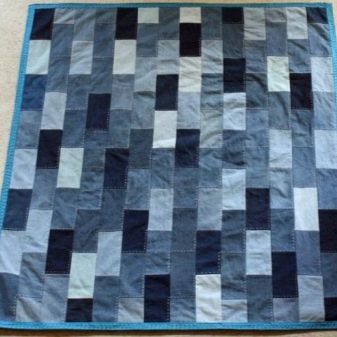
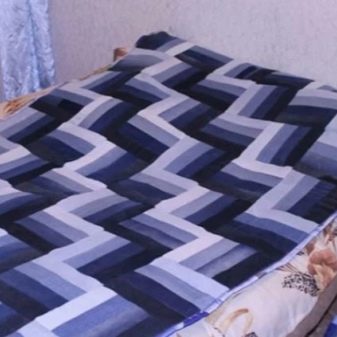
Which fabric is right for you?
A denim blanket can be made from old jeans. Sturdy pieces of jeans are required for this purpose.
It is not recommended to use places where the fabric is frayed or torn. A garment made with durable denim shreds can last a long time.
When choosing a material for a bedspread, it is important:
- use only one-piece, strong jeans flaps;
- take denim cuts of the same shade;
- when combining multi-colored flaps, it is better to choose the fabric that is the same in structure and thickness, so that individual fragments of the canvas do not stand out and do not spoil the overall impression of the thing;
- pieces of fabric with holes, patch pockets, or rivets are not suitable for making bedspreads.
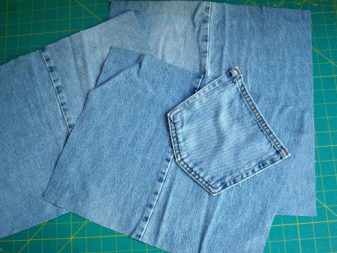
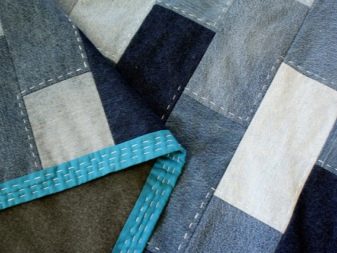
Required tools
To create a piece of worn jeans, you need to arm yourself with the materials and tools necessary for this work.
- Unnecessary jeans, preferably multiple pairs. First of all, you need to prepare the raw materials: carefully select pieces of fabric suitable for sewing, do not take places with yellowness or a changed color into work.
- Choose a fabric for lining... The bottom of the bedspread should be strong, soft and warm. For this purpose, it is advisable to choose a fabric made from natural fibers, it is best to use wool, satin, linen. In order to save money, instead of wool, you can use a padding polyester cloth or batting. Then, as a lining material, you can take any thin cotton fabric of a suitable color or solid color.
- Choose a fabric for edging along the entire perimeter of the bedspread.
- The threads and sewing needles must be thick and strong.... Stitching denim is tricky due to its thickness. It is better to take the threads in color to match the main fabric or contrasting ones in order to visually highlight the sewn details and elements.
- Thick cardboard for making a stencil template, a measuring tape, a pencil, a thin piece of dried soap or chalk for marking parts on pieces of fabric.
- Tailor's needles for chipping off parts before sewing, sharp tailor's scissors, a special knife for ripping seams or small scissors for manicure.
- Sewing machine... Special foot for seaming heavy, coarse fabrics.
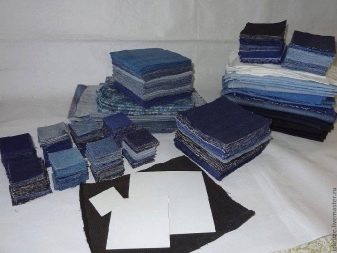
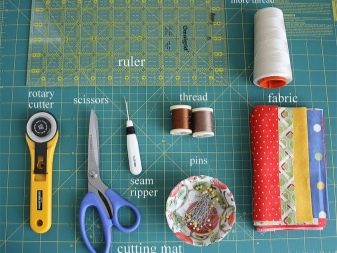
How to sew with your own hands?
If you have little or no experience in sewing such products, watch a master class by experienced craftswomen on the Internet. Visual videos or step-by-step photographs give a complete picture of the work ahead, which is divided into certain sequential stages.
First step.
- You should decide on the basic materials, prepare all the necessary tools, decide what kind of bedspread will be: single-layer, double-layer, with or without decor. Prepare raw jeans and additional fabric for the bottom of the bedspread and its edging.
- Make an accurate calculation of the squares (other elements), determine their size depending on the desired width and length of the bedspread. At this stage, it is necessary on paper to conditionally divide the entire canvas of the future bedspread into equal squares and calculate their dimensions, also calculate the number of edging, adding 5 cm from each edge.You will get 2 widths and 2 lengths with the addition of 5 cm on each side (in total complexity you need to add 40 cm).
- Prepare stencils made of thick paper or cardboard.
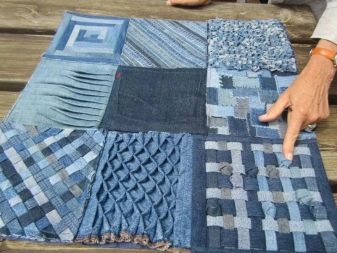
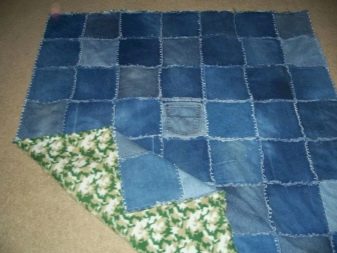
Second phase.
- Choose schemes, patterns of the future product, depending on the taste, desire and imagination of the craftswoman. Beginners most often take the Quick Squares scheme, more experienced needlewomen prefer the Well, Watercolor or Crazy Patchwork technique.
- Cut the fabric into separate parts, mark on each seam allowance and carefully stitch together. The result is a one-piece fabric sewn from individual pieces of jeans. When cutting, you should take into account the location of the share and transverse threads, make sure that one side of the square goes along the share, and the other - along the transverse. This cutting allows you to avoid deformation of the product after washing.
- It is more convenient to sew squares in one row, then sew all rows together. To do this, each square must be connected to the other using tailor's needles and sewn. Ready-made semi-finished strips should be steamed well and the seams should be smoothed. Then grind all strips along their length and iron the seams in the same way.
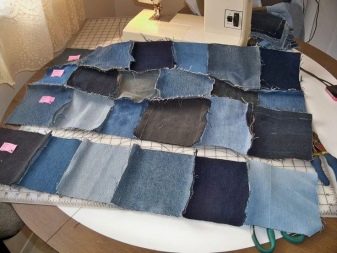

Stage three.
- Give the product its final look. Wash gently, dry and iron with steam.
- Decorate the bedspread with additional materials if desired. The perimeter of the product can be decorated with a beautiful fringe, braid. Crocheted bedspread looks spectacular.
Do not be afraid to experiment, turn on your imagination and enjoy the creative process. It will get better every time. And the interior will sparkle with new colors when it is decorated with warm things with a special energy, created with love and care.
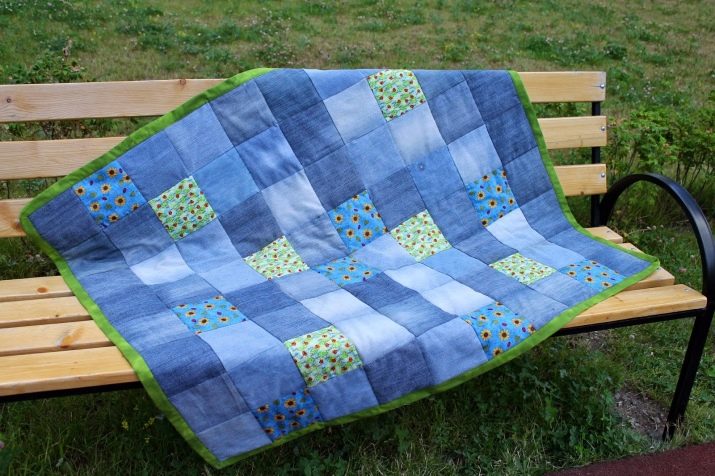
To learn how to sew a blanket from denim patches, see the video.








